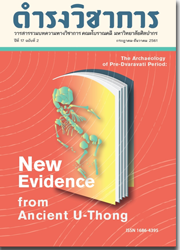The Motifs and Interaction of the Politics in Sinsai Lao Literature with the Sinsai Lao Duangduan
Keywords:
Sinsai Lao Duangduan, Sinsai Lao Literature, Interaction, Political, MotifAbstract
The purpose of this article is to study object-related motifs in the literature of Sin Sai Lao, which interact with Sin Sai Lao Duangduan based on the concept of motifs and the concept of interaction.
The results of this research are as follows: 1. The object-related motifs in the literature of Sin Sai Lao which appear in Sin Sai Lao Duangduan, they were changed into other motifs. The object-related motifs in Sin Sai Lao Duangduan reflect the author's findings of a linkage between Nang Soumountha's motifs and the political dimensions in the form of party and government and the interaction of Sin Sai Lao literature with Sin Sai Lao Duangduan in the form of historically political events such as fighting for the independence of the nation and reflecting the political meanings through the Lao People's Revolutionary Party's flag which is a symbol of unifying the nation on behalf of the party and government; 2. The object-related motifs in both the literature of Sin Sai Lao and the Sin Sai Lao Duangduan reflect the sub-motif, the interaction, and cultural and political meanings in the text of Sin Sai Lao. When the main characters such as Siho and Sangthong, clothing, costumes, and fighting for Nang Soumountha in the literature of the Sin Sai Lao appear in Sin Sai Lao Duangduan, they are changed and modified for having political dimension and the image of political stability in Laos.
These are not found in other literatures of Sin Sai Thai in Thailand. Therefore, it is an important dimension that reflects the interaction and creation of motifs in both Sin Sai Lao literature and Sin Sai Lao Duangduan as well as systemically reflecting Lao cultural dimension and Lao politics.
References
กาญจนา แก้วเทพ, 2557. ศาสตร์แห่งสื่อและวัฒนธรรมศึกษา. พิมพ์ครั้งที่ 3. กรุเทพฯ: ภาพพิมพ์.
คณะบอริหารงานสูนกางพรรค, 2016. กฎระเบียบพรรคประชาชนปฏิวัติลาว สมัยที่ 10. พิมพ์ครั้งที่ 1. โรงพิมพ์แห่งรัฐ นครหลวงเวียงจันทน์.
ตรีศิลป์ บุญขจร, 2549. วรรณคดีเปรียบเทียบ: กระบวนทัศน์และวิธีการ. พิมพ์ในอนุสรณ์งานพระราชทานเพลิงศพเป็นกรณีพิเศษ นางทองสุข บุญขจร. กรุงเทพฯ: ม.ป.พ.
ทองคํา อ่อนมะนีสอน, 1992. วัดจะนานุกมพาสาลาว. เวียงจัน: โตโยตายี่ปุ่น.
ทองคํา อ่อนมะนีสอน, 2008. วัดจะนานุกมพาสาลาว. เวียงจัน: หอสะหมุดแห่งซาดลาว.
ทองคํา อ่อนมะนีสอน, 2011. บทบาทนางสุมุณฑา และเชาว์ปัญญาสินไซ. เวียงจัน: สํานักพิมพ์จําหน่ายหนังสือแห่งรัฐ.
บ่อแสงคํา วงดาลา และคณะ, 1987. วันนะคะดีลาว. เวียงจัน: วิสาหะกิดการพิมพ์จําหน่ายศึกษา.
ประคอง นิมมานเหมินท์, 2543. นิทานพื้นบ้านศึกษา. กรุงเทพฯ: จุฬาลงกรณ์มหาวิทยาลัย.
ประคอง นิมมานเหมินท์, 2545. นิทานพื้นบ้านศึกษา. กรุงเทพฯ: จุฬาลงกรณ์มหาวิทยาลัย.
พระบุนทะวี กมพะพัน, 2016. สังสินไซ. วัดดงเหมี้ยง.
รัฐธรรมนูญแห่ง สปป.ลาว, 2015. ฉบับปรับปรุง เลขที่ 63/สพช นครหลวงเวียงจันทน์.
ราชบัณฑิตยสถาน, 2556. พจนานุกรม ฉบับราชบัณฑิตยสถาน พ.ศ. 2554. พิมพ์ครั้งที่ 2. กรุงเทพฯ: ราชบัณฑิตยสถาน
ศิราพร ณ ถลาง, 2552. ทฤษฎีคติชนวิทยา: วิธีวิทยาในการวิเคราะห์ตำนาน-นิทานพื้นบ้าน. กรุงเทพฯ: จุฬาลงกรณ์มหาวิทยาลัย.
ส. เดชา, 1981. กลอนลำลาวดวงเดือน. สํานักพิมพ์จําหน่าย สปป.ลาว: โรงพิมพ์แห่งรัฐ
สิลา วีระวงส์, 1949. สังสินไซ. สถานที่พิมพ์กระทรวงธรรมาธิการ.
สิลา วีระวงส์, 1969. สังสินไซ. พระนคร: โรงพิมพ์แสงศิลป์.
คําผุย พนลือชา. อาจารย์สอนภาควิชาภาษาและวัฒนธรรมลาว มหาวิทยาลัยแห่งชาติลาว.สัมภาษณ์เมื่อวันที่ 5 มกราคม 2561.
ศาสตราจารย์ ดร. บัวลี ปะพาพัน. ประธานหลักสูตรสาขาภาษาและวัฒนธรรมลาว ปริญญามหาบัณฑิต และหัวหน้าศูนย์วิจัยภาษาและวัฒนธรรมลาว มหาวิทยาลัยแห่งชาติลาว. สัมภาษณ์เมื่อวันที่ 15 กันยายน 2560 และวันที่ 5 มกราคม 2561.
Downloads
Published
Issue
Section
License
บทความนี้เป็นผลงานของข้าพเจ้าแต่เพียงผู้เดียว และ/หรือเป็นผลงานของข้าพเจ้าและผู้ร่วมงาน ตามชื่อที่ระบุในบทความจริง และเป็นผลงานที่มิได้ถูกนำเสนอหรือตีพิมพ์ที่ใดมาก่อน





